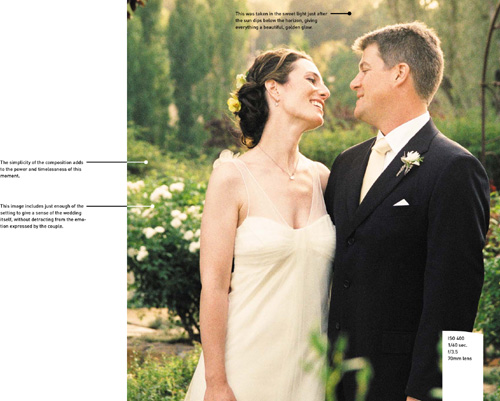9. Organizing and Presenting Your Work
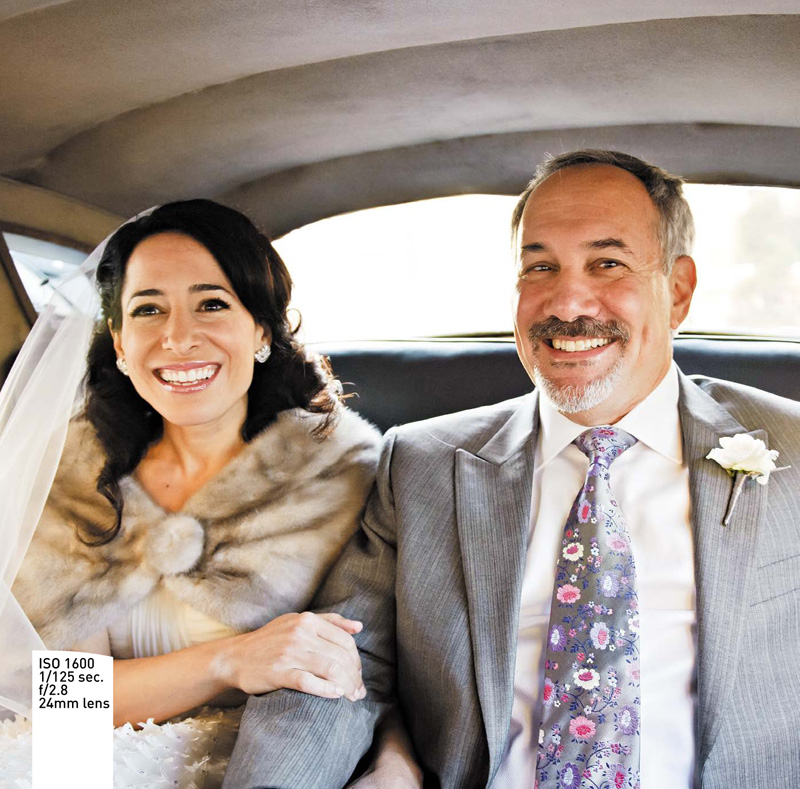
Ideas and Resources
The wedding’s finished and you not only survived—you rocked it! So, your job’s done, right? Wrong!
When it’s all said and done, you may end up with thousands of images from the wedding, and the sheer quantity is enough to overwhelm most clients. You need to edit, organize, and present your work in such a way that the couple and their guests can easily navigate, appreciate, and enjoy the images—not to mention order prints, albums, and other items, if you choose to offer them.
Poring Over the Picture
Many online proofing sites feature a cover image that is the first thing the couple (and everyone else viewing the proofs) will see. Choose this image carefully, because it will set the tone for how they view everything to come. I always choose a beautiful, timeless, emotion-filled portrait of the couple.
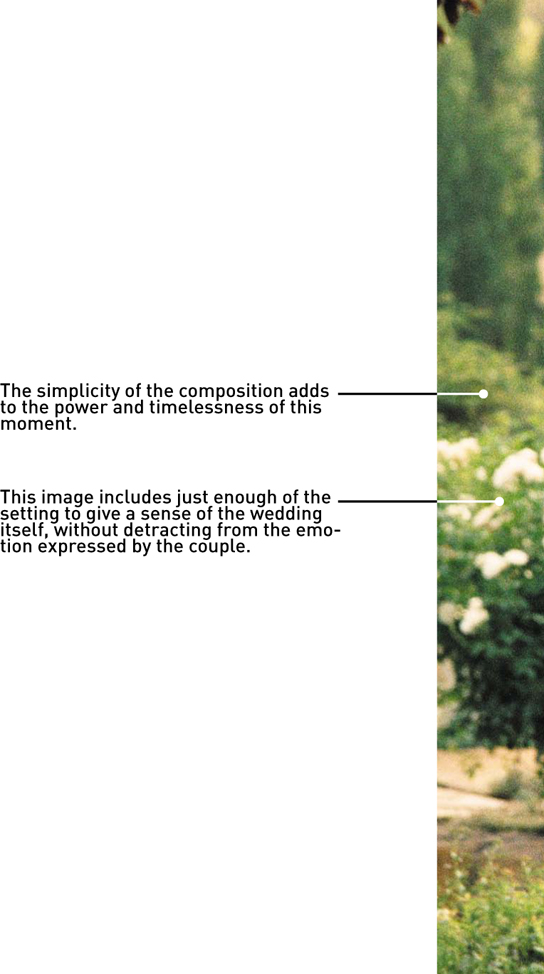
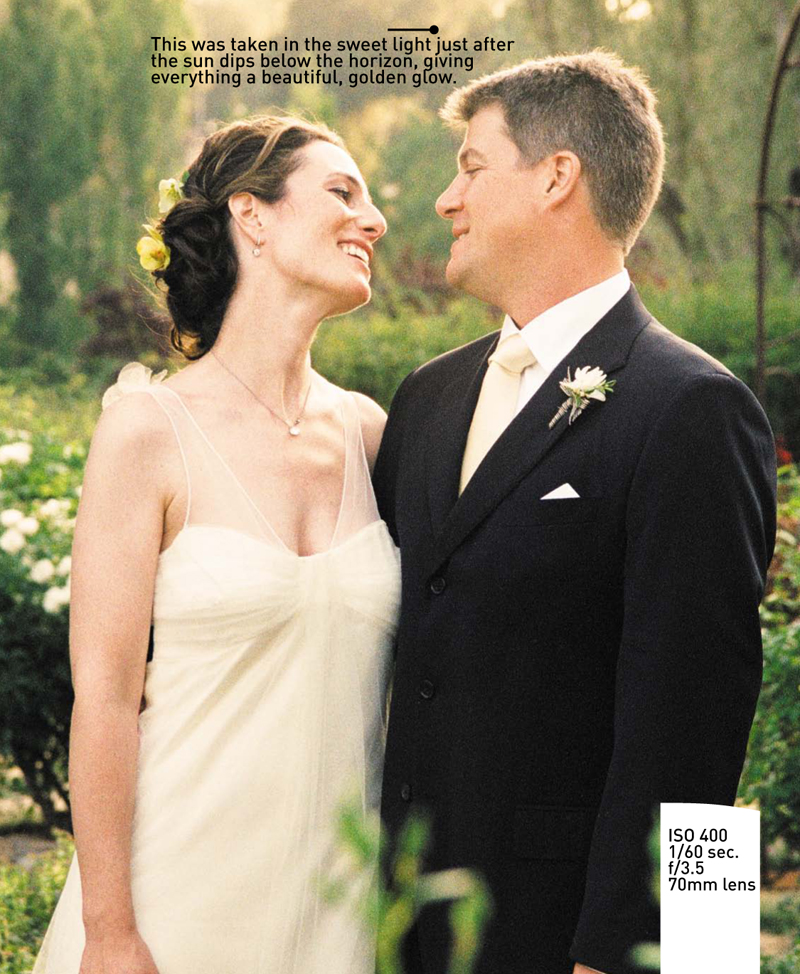
Editing Images
Editing images for your clients is nearly as important as the shooting itself. You’ve no doubt captured some magnificent shots, but if they’re buried in a sea of unexceptional and repetitive work, they may very well go unnoticed and unappreciated.
Think of Michelangelo, chipping away at the block of stone to discover the statue within. Likewise, you need to edit and shape your massive pile of images to reveal the narrative of the day and highlight the truly exceptional shots.
I usually end up with well over 2,000 images. Such a large number is daunting not only to clients, but to me! I generally deliver 600 to 700 images to my clients, and I have a two-step process to get to that number.
1. On my first pass, I edit in broad strokes, reducing the number of images and organizing them into categories so that I can begin to see the story taking shape.
2. On my second pass, I dig deeper and fine-tune the ultimate selection and organization of images that I’ll present to the client.
In the following sections, I cover these two steps.
Figure 9.1. Both images are beautiful, but the groom’s expression in the image on the right has more emotional impact, and the image on the left has a flare on the bride’s hair. The image on the right is the winner.
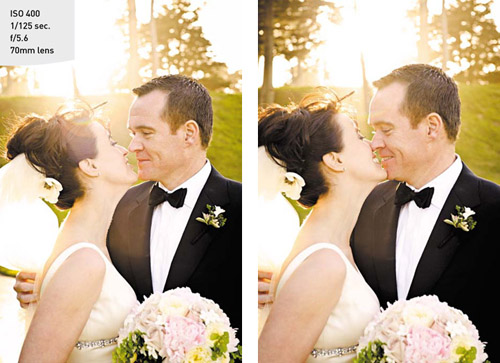
Categorizing images
I usually end up rejecting over half the images in my first pass. At the same time, I start putting them into smaller, more manageable piles by sorting them into categories based on chronological order. This makes it much easier to make sure I have all the bases covered and to see the story taking shape. Categorizing images is also really helpful to the client, because it divides the work into more easily digestible chunks and makes it easier to navigate.
Here is a sample list of categories that you might use:
• Highlights (see the sidebar below)
• Details
• Ladies getting ready
• Guys getting ready
• Before the ceremony
• Processional
• Ceremony
• Recessional
• Post-ceremony
• Couple portraits
• Cocktail hour
• Dinner
• Toasts
• First dance
• Parent dances
• Cake cutting
• Reception and dancing
• Family and group portraits
Fine-tuning your selection
After I’ve culled down the images and categorized them, I take another pass to fine-tune the presentation. During this phase of editing, I think in greater depth about how the images will ultimately come together to tell the story of the day. I’m always envisioning the final album when editing, and I make sure that all the major events are covered.
Figure 9.2. Images like this one give a feeling for the celebration and help transition between different parts of the day when designing the album.
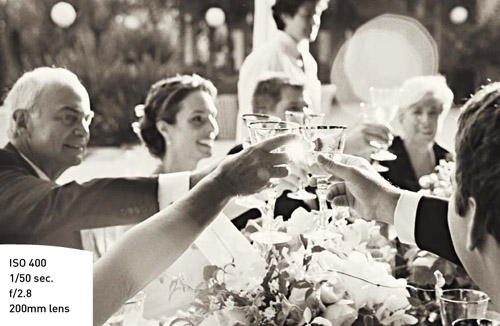
Figure 9.3. This image features guests in motion from one portion of the day to the next, making it a natural transition shot.
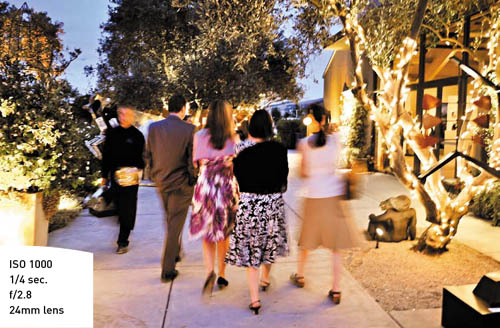
I also keep a lookout for good transitional images that signal to the viewer that the story is shifting from one segment of the day to another. For instance, a sweet close-up of glasses clinking during a toast can help to either introduce or close out that portion of the day in the album, which makes for smoother, more fluid storytelling (Figure 9.2). Other images that serve this purpose include, say, guests walking to the cocktail area (Figure 9.3), a beautiful room shot, cocktail-hour and dinner overviews, and so forth.
I also keep an eye out for small sequences of images—usually sets of three—that would work well together to tell a little self-contained story within the story. Examples include the sequence of a kiss (before, during, and after), or a series of beautiful first-dance images (Figures 9.4, 9.5, and 9.6). When I edit the images, I place these images together to help the client see the design possibilities.
Figure 9.4. These images work well together to tell the story of the first dance, opening with an overview-type shot.

Figure 9.5. Next, a sweet close-up that captures the emotion.
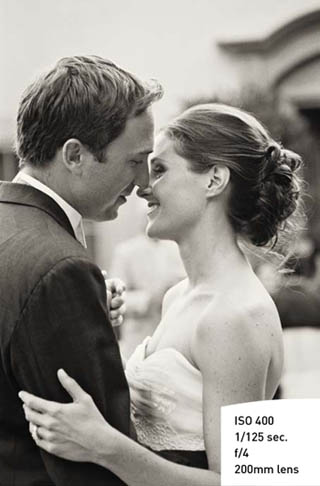
Figure 9.6. Finally, the dip. By creating sets of images like this, you can help your client visualize the narrative of the day.
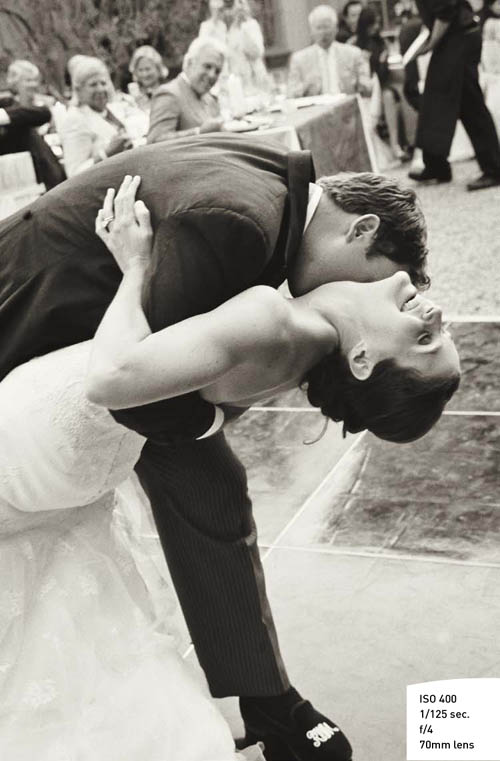
Proofing Options
If you ask ten different wedding photographers how they present proofs to their clients, chances are good that you’ll get ten different answers. Some photographers offer only online presentation of images, with no hard-copy proofs at all. Others provide gorgeous sets of 4x6 proof prints of every image. Still others (myself included) deliver sleek press-printed books with multiple images per page.
You’ll need to do some research into what other photographers in your area offer, think about your business model (for example, if you want to sell albums after the wedding, you may not want to offer everything upfront), and get to know the needs of your own clientele (what they request when they meet with you). Whatever you decide to offer, do it with confidence and be sure to explain the benefits of your chosen proofing method to your clients when you meet with them, because most of them don’t know the pros and cons of the different options.
There are far too many options and services to list them all, but I’ll give an overview of the different media, some important features to consider, and some resources for further research.
Online
There is no real industry standard in terms of what type of proofing products are delivered to clients, but I would argue that you really must make the images accessible online. Couples expect to be able to view and share their images in this way. Plus, it’s a great way for you to expand the reach of your work, because many friends and family members will take the time to view the images.
A number of companies provide this service, and several offer related services and products as well, such as print-order fulfillment, albums, and other items both for photographer and consumer use. I did an informal survey of my colleagues, and the following are some of the more popular and reputable services:
• PickPic www.pickpic.com
• Pictage www.pictage.com
• RedCart www.redcart.com
• Zenfolio www.zenfolio.com
Each service is structured differently, so you’ll need to do some research to find the best fit for your needs. Some features to compare include the following:
• Pricing structure Some companies charge a monthly fee for unlimited image uploads; others charge on a per-event or per-image basis; and still others charge a larger, one-time-only fee. Obviously, the option that is most cost-effective for you will depend on how many weddings you shoot and how many images you present to the client.
• Website interface How does it look? Is it easy to use, both for you as the photographer and for your clients? Be sure to evaluate its use from both perspectives. How much can you customize the interface, both visually (to match your branding) and in terms of the functionality you want to offer your clients?
• Privacy Are all events password-protected?
• Print/product-order fulfillment Do you want your clients to be able to order prints and other products through the site? Some companies not only host the proofing site, but also fulfill print orders and send them either directly to the client or to your studio. Others simply send you a record of the order so that you can take it to any lab you like, which is obviously more time-consuming but gives you greater choice in vendors. Think about which option fits best with your studio setup, your lifestyle, and your vision for your business.
• Other services that add value Some companies, such as Pictage, present themselves as a one-stop solution for photographers. They offer a number of additional low- or no-cost services, such as album design, credit card processing, community forums, and so forth. Be sure to factor these types of extras into your comparison if you would find them useful.
Digital
Another way to present the proof images to the client is on a CD. I give my clients a CD with low-resolution images that are suitable for e-mailing, posting on social media sites like Facebook, and so on, but that aren’t large enough to print. When discussing this with my clients, I let them know that the biggest reason I maintain control over printing the images is that I want them to be of the highest quality—after all, the work will have my name on it, so I want it to be the best it can be.
Many labs offer great CD packaging. You can choose something simple like a colorful sleeve with your logo printed on it or a deluxe foldout case with spots to attach images from that particular wedding. Putting a little effort into creating a nice presentation for the client really goes a long way toward presenting a professional image.
Hard copy
Many clients still want their proofs in some hard-copy format—something that they can hold and touch. When I started doing wedding photography in 1997, individual proof prints were the only option for hard-copy proofs. Now, in addition to loose prints presented in either a box or proof albums, there are also great-looking press-printed books and image magazines.
Naturally, there are pros and cons to both approaches:
• Proof prints (Figure 9.7):
Pros: High perceived value for some clients, easy for clients to sort and make piles when selecting images for the album
Cons: Bulky (depending on how many images are delivered), harder for clients to carry and show friends, easy to get disorganized, easy to lose images, may depress sales of reprints and albums
• Press-printed books (Figure 9.8):
Pros: Sleek, elegant look; neatly contain a large number of images; easy for client to carry and share with friends; impossible to lose individual proofs
Cons: Can’t sort into piles when selecting images for the album
Years ago, every client wanted individual proof prints. Although I do get the occasional request for prints, these days most clients see the advantages of a more streamlined presentation—especially considering the large number of images that they receive.
I provide clients with a hardcover proof book that features four images per page, categorized and numbered consistently with the proofing website. With the book, clients can easily flip through to locate specific images, and with the proofing website, they have the functionality to create virtual “piles”—folders of favorites, album selections, print orders, and so forth. Used together, the book and the site provide the client with powerful tools to manage their images.
Figure 9.7. Proof prints have many virtues, but with so many images, I find that they’re easily mixed up or misplaced.
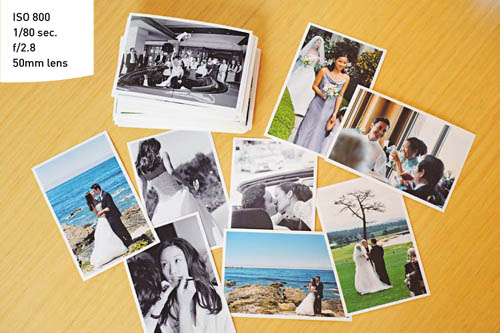
Figure 9.8. Many clients appreciate the sleek elegance and ease of use of a press-printed proof book.
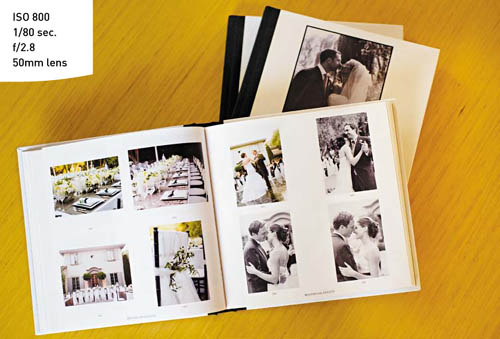
Albums and Thank Yous
Once the wedding has been shot, edited, and presented in proof form, the final step is to deliver your work in a beautiful way to the clients as well as to your colleagues. Offering gorgeous, professional quality albums is optional, but it’s a service that can add a great deal of value for your clients and ensure that the final presentation of your work is all that you wish it to be.
A brief primer on albums
As with proofing, there are many different approaches to offering albums. Typically, I ask couples to select their favorite images and I use those as the basis for the album design. I then give them the opportunity to review the design and make any needed adjustments before the album is actually printed. Other photographers choose to select the images themselves and present the client with a completely finished album design, sometimes at the same time that they present the proofs. Photographers who work this way make sure to discuss the album process at their very first meeting with the client, and lay the foundation well in advance so that client understands what to expect.
There are many album companies and even more types of albums, including digital flush-mount (each page is a sheet of photo paper mounted on a cardboard core), classic-matted albums, and press-printed books available on various paper types—just to name a few. Whether you want a sleek, modern look, a handmade, vintage feel, or an eco-friendly album, there is an album company catering to your needs. When selecting a supplier, you should research the quality of the albums as well as the customer service. Make sure to talk with other photographers who may have used them to get the real scoop.
Another factor to consider when selecting an album supplier is the design and order process. Some companies have their own proprietary software that must be used when designing the album, others work with third-party software such as Photojunction, and some offer the actual album design as a service—often free of charge—or feature pre-designed templates that you can use. Some companies offer color-correction of the images as an added service, and some require you to send images that have already been fully processed and prepared for printing.
The following list of album suppliers is by no means exhaustive, but it will give you a good starting point for what is available:
• AsukaBook www.asukabook.com
• Bay Photo Lab www.bayphoto.com
• Couture Book www.couturebook.com
• Cypress www.cypressalbums.com
• Finao www.finaoonline.com
• Leather Craftsmen www.leathercraftsmen.net
• Michael Chinn Albums and Boxes www.michaelchinnphoto.com
• Pictage www.pictage.com
• Priscilla Foster Handmade Books www.priscillafoster.com
• Queensberry www.queensberry.com
• Simply Color Lab www.simplycolorlab.com
• White House Custom Color www.whcc.com
There are many sources for inexpensive albums that are available to consumers as well as photographers, such as www.blurb.com and www.mpix.com. These are really useful if you are shooting a few weddings here and there for friends, or just need to create some initial samples quickly and inexpensively. If you plan to offer albums as a part of your wedding business, though, I recommend working with labs that cater to the needs of professional photographers, as you will have many more options in terms of cover materials, paper, and so forth. You will also have more “wow” power with your clients if you can offer them items that are not readily available to the average consumer.
Thank Yous
Finally, don’t forget to take care of the other vendors that worked so hard to create the beautiful décor, food, and other details that made the wedding day a success. A hand written note and a few prints—or even a well-designed press-printed album—along with a disc of images featuring the work of the wedding planner, designer, florist, caterer, site manager, lighting company, cake baker and so forth are always well-received and may just help you land your next gig!
Chapter 9 Assignments
Tell a Story
Photograph an event—say, a family vacation or a child’s birthday party—with a narrative in mind. Afterward, edit your work to tell the story of the event, selecting a variety of images (details, people, overviews, and so on) that create a narrative that smoothly flows from beginning to end.
Practice Proofing
Research the available online proofing options and create a test account at one of them. Upload images from an event (like the family vacation or birthday party mentioned above), give the URL to a friend, and have him go through the process of proofing so you have experience working with a “client” on this part of the process. You’ll gain familiarity with setting up the proofing site, and by discussing the experience with your friend, you can gain insight into the viewer experience of the site before you try it for real with a client.
Share your results with the book’s Flickr group!
Join the group here: flickr.com/groups/weddingsfromsnapshotstogreatshots

